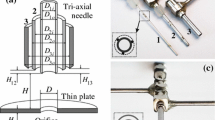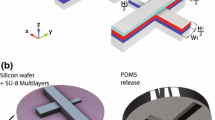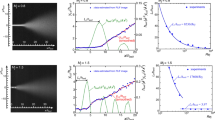Abstract
A focused jet is an axisymmetric jet of liquid surrounded by an outer coaxial gas jet. The gas jet is typically used to compress the liquid jet in the radial direction thereby focusing it. At microscales, it is difficult to manufacture micro-scale delivery nozzles (needles) and to consistently align and axially position the liquid and the gas needles. However, it is very easy, using standard etching technologies to make precise and repeatable rectangular nozzle designs. This work will therefore explore the geometric and fluid dynamics constraints that allow one to design rectangular nozzles that produce round coaxial micro-jets of liquid and gas. Because of the small scales, the fluid dynamics of the focusing jet is unusual, and this work demonstrates that the liquid jet is best focused by shear stretching and not via gas compression. This paper shows that sheet jetting occurs when the Reynolds number of the gas is too high. Dripping occurs when the Weber number of the liquid is too low. The desired round jet occurs by balancing Weber number of the liquid jet and Reynolds number of the gas such that surface tension at the interface holds the water jet round while the acceleration of the water jet due to shear at the interface from fast-moving air causes the liquid jet cross-sectional area to decrease. The goal of this initial paper is to demonstrate that a parameter region exists where this flow behavior is possible.
Similar content being viewed by others
Abbreviations
- U :
-
Velocity
- ρ :
-
Density of fluid
- μ :
-
Viscosity of fluid
- α:
-
Volume fraction of liquid phase
- Θ:
-
Material property of fluid
- k:
-
Turbulent kinetic energy
- ω:
-
Specific rate of turbulence dissipation
- μ T :
-
Turbulent viscosity
- L WaterInlet :
-
Length of side of square water inlet
- h Outlet :
-
Height of outlet of nozzle
- Wb Water :
-
Weber number of water at the water inlet
- Re Air :
-
Reynolds number of air at nozzle outlet
- ṁ air :
-
Mass flowrate of air in nozzle
- ṁ water :
-
Mass flowrate of water in nozzle
- D :
-
Diameter of liquid jet at outlet
- D 0 :
-
Diameter of liquid jet at mesh resolution specified
References
B. de Gans, P. C. Duineveld and U. S. Schubert, Inkjet printing of polymers: State of the art and future developments, Advanced Materials, 16 (3) (2004) 203–213.
B. Derby, Inkjet printing of functional and structural materials: Fluid property requirements, feature stability, and resolution, Annual Review of Materials Research, 40 (2010) 395–414.
O. Carneiro, A. Silva and R. Gomes, Fused deposition modeling with polypropylene, Materials & Design, 83 (2015) 768–776.
S. Som, A. I. Ramirez and D. E. Longman, Effect of nozzle orifice geometry on spray, combustion, and emission characteristics under diesel engine conditions, Fuel, 90 (3) (2011) 1267–1276.
G. Faeth, L. Hsiang and P. Wu, Structure and breakup properties of sprays, International Journal of Multiphase Flow, 21 (1995) 99–127.
H. N. Chapman, P. Fromme and A. Barty, Femtosecond Xray protein nanocrystallography, Nature, 470 (7332) (2011) 73.
D. DePonte, U. Weierstall and K. Schmidt, Gas dynamic virtual nozzle for generation of microscopic droplet streams, Journal of Physics D: Applied Physics, 41 (19) (2008) 195505.
S. V. Fridrikh, H. Y. Jian and M. P. Brenner, Controlling the fiber diameter during electrospinning, Physical Review Letters, 90 (14) (2003) 144502.
D. Oberthuer, J. Knoška and M. O. Wiedorn, Double-flow focused liquid injector for efficient serial femtosecond crystallography, Scientific Reports, 7 (2017) 44628.
A. M. Gañán-Calvo and J. M. Montanero, Revision of capillary cone-jet physics: Electrospray and flow focusing, Physical Review E, 79 (6) (2009) 066305.
G. H. McKinley and M. Renardy, Wolfgang Von Ohnesorge, Physics of Fluids, 23 (12) (2011) 127101.
M. Trebbin, K. Krüger and D. DePonte, Microfluidic liquid jet system with compatibility for atmospheric and highvacuum conditions, Lab on a Chip, 14 (10) (2014) 1733–1745.
M. Rosello, G. Maîtrejean and D. C. Roux, Influence of the nozzle shape on the breakup behavior of continuous ink jets, Journal of Fluids Engineering, 140 (3) (2018) 031202.
I. Ngo, S. W. Joo and C. Byon, Effects of junction angle and viscosity ratio on droplet formation in microfluidic cross-junction, Journal of Fluids Engineering, 138 (5) (2016) 051202.
B. Carroll and C. Hidrovo, Droplet detachment mechanism in a high-speed gaseous microflow, Journal of Fluids Engineering, 135 (7) (2013) 071206.
H. Jasak, A. Jemcov and Z. Tukovic, OpenFOAM: A C library for complex physics simulations, International Wokshop on Coupled Method in Numerical Dynamics, 1000 (2007) 1–20.
Y. Bellouard, A. Said and M. Dugan, Fabrication of highaspect ratio, micro-fluidic channels and tunnels using femtosecond laser pulses and chemical etching, Optics Express, 12 (10) (2004) 2120–2129.
I. Ansys, Cfd, ICEM CFD Theory Guide, Ansys Inc. (2015).
A. Henderson, J. Ahrens and C. Law, The ParaView Guide, Kitware Inc, Clifton Park, NY (2004).
J. Towns, T. Cockerill and M. Dahan, XSEDE: Accelerating scientific discovery, Computing in Science & Engineering, 16 (5) (2014) 62–74.
S. S. Deshpande, L. Anumolu and M. F. Trujillo, Evaluating the performance of the two-phase flow solver interfoam, Computational Science & Discovery, 5 (1) (2012) 014016.
B. E. Larsen, D. R. Fuhrman and J. Roenby, Performance of interfoam on the simulation of progressive waves, Coastal Engineering Journal (2019) 1–21.
F. R. Menter, Two-equation Eddy-viscosity turbulence models for engineering applications, AIAA Journal, 32 (8) (1994) 1598–1605.
V. Inguva, S. V. Kathuria and O. Bilsel, Computer design of microfluidic mixers for protein/RNA folding studies, PloS One, 13 (6) (2018) e0198534.
J. D. Anderson, Modern Compressible Flow: With Historical Perspective, McGraw-Hill, 12 (1990).
Acknowledgments
We would like to thank NSF for funding this work. The work is supported by NSF IDBR Award No. 1353942. We acknowledge the Texas Advanced Computing Center (TACC) at The University of Texas at Austin for providing HPC, visualization and database resources that have contributed to the research results reported within this paper.
Author information
Authors and Affiliations
Corresponding author
Additional information
Recommended by Associate Editor Donghyun You
Venkatesh Inguva is a Post-doctoral Researcher at Universität Paderborn. He completed his Ph.D. at the University of Massachusetts Amherst. His research involves the use of computational and experimental fluid dynamics to study flows in microchannels.
Rita Graceffa is a Scientific Officer at the Industrial Liaison Office at the European XFEL. She has experience in studying micro and milliseconds timescale kinetics initiated by fast mixing, by coupling microfluidics and x-rays.
Joachim Schulz is the Group Leader for Sample Environment & Characterization at the European XFEL. His research covers sample preparation and delivery methods for high repetition rate X-ray sources. Liquid jet sample delivery for serial femtosecond crystallography on protein crystals is a focus of this research.
Osman Bilsel is a Professor at University of Massachusetts Medical School. His research focuses on the mechanisms of protein folding and misfolding. He uses microfluidic mixers, time-resolved fluorescence and small-angle x-ray scattering to better understand early events in protein folding.
Blair J. Perot is a Professor at the University of Massachusetts Amherst. His research spans the full spectrum of using computers to solve fluid dynamics problems, from developing numerical techniques to applied research topics in microfluidics and wind turbines.
Rights and permissions
About this article
Cite this article
Inguva, V., Graceffa, R., Schulz, J. et al. Creating round focused micro-jets from rectangular nozzles. J Mech Sci Technol 33, 4281–4289 (2019). https://doi.org/10.1007/s12206-019-0824-x
Received:
Revised:
Accepted:
Published:
Issue Date:
DOI: https://doi.org/10.1007/s12206-019-0824-x




